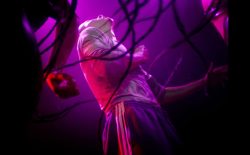In a contemporary retelling of the medieval morality tale Les Visions Du Chevalier Tondal directors Louis-Jack and Jăk Skŏt have enlisted the talents of movement artist Magnus Westwell, CGI artist Enes Güç, designer AGF Hydra and producer and sound artist IVVVO to relocate a Boschian vision of purgatory to a contemporary club basement.
Artists and directors Louis-Jack and Jăk Skŏt hold up a kaleidoscopic lens to contemporary club culture, queer communities and collective celebration in Tondal, a film project that transplants the medieval morality narrative Les Visions Du Chevalier Tondal, which narrates the tale of a rich and wayward knight whose soul is lead through heaven and hell by a guiding angel, into the chaotic hedonism of a London nightclub. Drawing particular inspiration from French artist Simon Marmion’s 1475 illumination of David Aubert’s manuscript, as well as Hieronymus Bosch’s 1479 hellscape, Tondal’s Vision, the artists have assembled an incredible cast of talent, including movement artist Magnus Westwell, CGI artist Enes Güç, designer AGF Hydra and producer and sound artist IVVVO, to capture a lone revellers hallucinogenic journey, untethered from reality and enveloped by a nocturnal fantasy. “The global pandemic has made us all critically attuned to the importance of shared communion,” the directors assert. “In its wake, Tondal presents an urgent reflection on how our sites of collective revelry, once radical spaces of communal liberation, are being pervaded by hyper-individualism and commercialisation. Often lost and alone, but longing to find his place in the night, Tondal’s journey champions the idea that collectivity is actually still achingly proximate; a personal and socially transformative spectre haunting even the most de-socialised spaces.”




In a gesture of narrative subversion, Louis-Jack and Jăk Skŏt queer the moral drive of Les Visions Du Chevalier Tondal, exploring the libidinal charge of club environments and positing communal celebration as a powerful strategy for navigating the relentless seeping of neoliberal economic interest into contemporary club culture, a collective retaliation against corporate osmosis. In the screen test presented above, a forerunner for a larger work in the making, this is achieved via a prolonged study of the body in complimentary states of disorientation and bliss, Magnus Westwell’s choreography perfectly capturing the overstimulation and dissociation of a lone dancer lost in the rave. Caught between the visceral physicality of instinctive movement and the sudden addled expansion of internal emotional landscapes, the frenetic intimacy of our protagonist enacts a heightened empathetic mode driving outward and inward simultaneously. The sheen of AGF Hydra’s apparel, picked out in neon lights, translates the lysergic illustrations of Marmion’s manuscript into a modern aesthetic language of sexual expression. Stroboscopic flashes reflecting off sweat speckled skin and latex shimmer lend the cinematic vision of director of photography Matthew J. Smith a hyper-saturated, computer-generated aesthetic, blurring the lines between media in a multidisciplinary homage to the director’s germinal act of literary adaptation.




Bodies entwined, faces turned heavenward and mouths open in ecstasy, Enes Güç envisions a sudden opening up, an intimate revelation of the inner complexity of our protagonist’s experience, rendered as a tangled mass of bodies, flesh cast as CGI statues, writhing together in an infinitely repeating somatic fractal, movement captured in stasis. The echoing cries of IVVVO’s eerie industrial score reverberate around this impossible structure, as weapons grade bass and percussive barrage melt into elongated vocal drones, a instant of surreal time dilation presenting a ravers eye view of the club as it might be depicted by Hieronymus Bosch, a frame of chaos exquisitely captured. Emerging transformed, blinking under purple spotlights, it’s clear that our protagonist has been exposed to some deeper understanding, the original allegory of the Tondal narrative reconstructed as the fleeting potential for political and sexual liberation. Quoting Frederic Jameson in his 2009 book Valences of the Dialectic, Louis-Jack and Jăk Skŏt leave us on a note of optimism: “From time to time, like a diseased eyeball in which disturbing flashes of light are perceived, or like those baroque sunbursts in which rays of light from another world suddenly break into this one, we are reminded that Utopia exists and that other systems, other spaces are possible.”

For more information about Louis-Jack and his work you can find him on Instagram and visit his website. You can find Jăk Skŏt on Instagram.
Tondal (Screen Test) Credits:
Directors – Louis-Jack & Jăk Skŏt
Director Of Photography – Matthew J Smith
CGI Artist – Enes Güç
Choreographer – Magnus Westwell
Composer – IVVVO
Stylist & Costume Designer – AGF Hydra
Editor – James Stubbs
Curator – Charlie Mills
Story & Script Consultant – Walter Donohue
Dancers – Oscar Li, Kibrea Carmichael and Max Cookward
Watch next: THUGWIDOW & Bruised Skies invoke creeping horror with ‘I Need It’




































